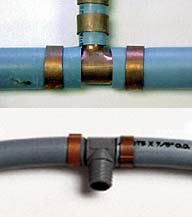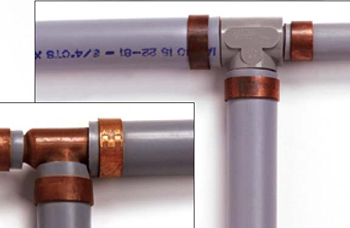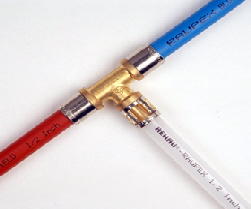Should You Buy a House With Polybutylene Pipes?
By Aztec Plumbing & Drains
02/04/2021
From about the late 1970s through the early 1990s, millions of homes across the country were constructed with polybutylene piping, one of many new building materials that were lighter, cheaper, and easier to produce than traditional metal materials. However, as these piping systems began to age, their reliability became questionable. Despite the manufacturer, Quest, staunchly arguing that studies done on these pipes do not prove they are dangerous and continually refuting claims of liability, their elevated failure rate led to the material being recalled. Today, class-action suits from homeowners who have suffered tremendous damage from these pipes are still continuing.
Since these pipes were largely utilized across the “sun belt” states, of which Florida is a part, it’s not uncommon for homes built between 1978 and 1995 to still have a polybutylene piping system. While many homeowners have undertaken the project of re-piping their home for better reliability and security, there are plenty of homes still out there even today that have continued to use these pipes for upwards of 25 to 40 years or more. So if you’re considering buying a house in the Fort Myers area and find that the home still relies on polybutylene piping, you may have some doubts as to whether or not you should make the purchase.
Six Spaces Home Staging

Contact: Hongliang Zhang
Tel: 571-474-8885
Email: zhl19740122@gmail.com
Will My Pipes Fail?
First things first, it’s extremely important that we put something out there: there is no guarantee that Quest polybutylene pipes will fail. While studies have shown at least some small amount of a causal link to polybutylene plumbing being risky, the truth of the matter is that any material can fail. Even modern plastics, copper, galvanized steel, and other materials that have long been utilized for their durability and longevity will eventually wear out with continual exposure to water. Quest piping has simply been shown to fail at a higher rate than many other materials.
In fact, studies have even suggested that the reason for polybutylene pipe failure is similar to the reason why your copper galvanized steel pipes will eventually fail—substances commonly found in public water supplies like chlorine would react with the material in polybutylene pipes, causing them to flake and scale. This caused the pipes to become brittle, resulting in microfractures that could create everything from pin-hole leaks to complete pipe failures without warning.
Should I Buy a House With Polybutylene Pipes?
Polybutylene piping should not dissuade you from making a purchase on your dream home, particularly if you’re in love with just about everything else about it. However, you should absolutely take a few extra precautionary steps before making any deal.
- First, hire a licensed and experienced plumber to inspect the home and determine the health of the plumbing system. This is a good idea in general, but critical if you have polybutylene plumbing because you want to be sure there are no potential or imminent serious issues.
- Second, you’ll want to review your homeowners’ insurance policy to ensure you’re protected. This is important: some homeowners’ insurance companies will not insure homes with polybutylene piping against flood damage caused by plumbing failures. Because these businesses are all about reducing risk, any known risk factors will usually not be covered.
- Finally, you may want to consider talking with the sellers of the home and working re-piping the home into the deal somewhere. You may be able to split the cost with them, or you may even be willing to pay for the cost of the service in order to have them do it before the deal closes. In any case, having a re-pipe service done before you close the sale and move in is significantly easier than trying to re-pipe your home after you’ve moved in with all your belongings.
Source: https://www.aztecplumbing.net/blog/2019/june/should-you-buy-a-house-with-polybutylene-pipes-/
Polybutylene for Inspectors
By Nick Gromicko, CMI® and Kenton Shepard
02/04/2021
Polybutylene (PB) was a plastic manufactured between 1978 and mid-1995 for use as piping in home plumbing systems. It was inexpensive and offered plenty of advantages over other materials, such as flexibility, ease of installation, resistance to freezing. Pipes made from polybutylene were installed in up to 10 million homes in the Unites States during that period. Despite its strengths, production was ceased in mid-1996 after scores of allegations surfaced claiming that polybutylene pipes were rupturing and causing property damage. In the homes that still contain this material, homeowners must either pay to have the pipes replaced or risk a potentially expensive plumbing failure.
How Does Polybutylene Fail?

Two studies in particular in papers published by the University of Illinois at Chicago have shown that certain disinfectants can react with the polybutylene and cause it to flake apart at any location within the PB piping system. Small fractures can deepen over time and eventually work their way to the pipe’s exterior, allowing water to escape. Some manufacturers, however, claim that the majority of leaks occur at joints and unions, which is where a leak would likely appear if a pipe were improperly installed. Despite this contention, class-action lawsuits filed against PB manufacturers have been successful and resulted in payouts to homeowners reaching $1 billion.
Polybutylene Pipes Should Be Replaced
Although no regulations require the replacement of polybutylene piping with other material, many plumbers recommend doing this, at a cost several thousand dollars. Leaking can happen without warning and can result in flooding and serious damage to a home’s interior if it is not immediately stopped. PB pipes installed behind sheetrock can leak unnoticed for long periods of time and cause mold and water damage. InterNACHI believes it is far cheaper to replace polybutylene pipes before they fail and release their contents onto floors, appliances and furniture. They can also reduce a home’s value or prolong its time on the market. Homeowners might face higher insurance premiums or be denied coverage entirely. For homeowners who are concerned about this problem and wish to replace the PB piping in their home with copper or other material, there are companies that specialize in this type of work.
Identifying Polybutylene
An inspector can use the following tips to identify polybutylene plumbing. Polybutylene pipes are:

- usually stamped with the code “PB2110”;
- flexible and sometimes curved, unlike rigid piping materials such as copper;
- not used for waste, drain or vent piping;
- most commonly grey in color, but they can also be white, silver, black or blue. Blue PB is used primarily outdoors and should only be used to carry cold water. Inspectors should be aware that black or white pipes might not be polybutylene (they might be polyethylene or PVC, respectively). Also, PB color is somewhat region-dependant. For instance, experienced home inspectors in California might never come across grey PB, while it is quite common elsewhere;
- ½” to 1” in diameter.
Polybutylene pipes can be in a home’s interior or exterior in any of the following locations:
Interior:
- protruding from walls to feed sinks and toilets;
- running across the ceiling in unfinished basements;
- near the water heater.
Exterior:
- entering the home through the basement wall;
- at the water meter;
- at the main water shut-off valve.
Note:
- Home inspectors are not required to note the presence of polybutylene, and no tests for weaknesses should be performed. Any deterioration of polybutylene pipes happens from within and cannot be detected without turning off the water and dismantling the pipe, which is far beyond the standards of practice of home inspection.
- Inspectors should check an entire pipe for PB, not just a portion of it. Some copper piping systems have been found to use PB at junctures. A common example of this union is where PB pipe links with copper “stub outs” that feed bathroom fixtures.
Other piping materials not to be confused with PB:

- PEX (pictured at right): Common in radiant-heating systems, this cross-linked polyethylene can be black, blue or red. It is more easily coiled and more flexible than PB. It can withstand higher temperatures than polyethylene.
- PVC: A popular building material commonly used in residential plumbing. CPVC is derived from PVC and is also used in plumbing. Both appear white or off-white and can be flexible or rigid.
- Polyethylene: This material is flexible and black.
- Copper: Copper is a metal that should never be confused with PB.
If in doubt, a licensed plumber can be contacted to determine whether or not a pipe is made from PB.

Source: https://www.nachi.org/pb.htm


02/04/2021
One of the biggest problems facing real estate professionals is what to do about homes with polybutylene. Some agents will not show a buyer a home with poly. If you’re representing a buyer, you wouldn’t want to sell your client a home with poly without them being made aware of the problems with poly.
Here are some facts you should note: (1) a broker was sued in Virginia for not disclosing the fact that a home had polybutylene plumbing, (2) a property management firm is being sued for non-disclosure in the condo resale certificates, and (3) an inspection company was sued for failing to disclose poly in a hotel property.
We’ve tried to outline some of the issues you are facing–or will be facing. If you have any additional questions, please feel free to call us. We also offer FREE presentations to real estate professionals, either in your office or at association meetings. Please call us for more details on presentations in your area.
What’s going on? The bottom line is…Courts continue to move away from “Buyer Beware” defenses. Different jurisdictions have different statutory requirements regarding disclosure, but the general atmosphere in the legal system is away from Caveat Emptor. Judges are looking at “what is the right thing to do.”
Stay ahead of the pack on this problem. As homes with poly age, the rate of poly leaks will increase dramatically. This is a multi-billion dollar problem in homes throughout the United States. Here are some tips to consider…
1. Representing a Buyer:
A. Ask the Listing agent if the home has poly. If it does, ask if they are going to replace it with copper or reduce the price of the home so your Buyer can replace the poly before they move in.
B. Conduct a visual inspection for gray poly pipes. Look under the sinks, around the hot water heater and in exposed basements. If you see gray pipes, you have a poly problem. As for the underground main, please reference our web page “How Do I Get Rid Of Polybutylene“.
C. If you’re not sure if the home has poly, order a home inspection or call Plumbing Express – 800-501-7702.
D. If the home has poly, be sure to disclose this material fact, in writing, to your client. If you fail to disclose this problem, and they buy the home with poly, when it leaks, they will most likely want to know why you didn’t warn them.
E. Disclosure Issues –
(1) Hundreds of Thousands of Poly Leaks,
(2) Potential for Catastrophic Damage from a Single Leak,
(3) Real Estate Professionals should have a waiver agreement for their Buyers to sign.
F. There are a lot of homes on the market with copper plumbing. Either sell them a home with copper or make sure the poly is replaced with copper.
G. Be sure to give every potential Buyer a Poly Information Kit. They are available FREE from Plumbing Express.

2. Representing a Seller:
A. Homes with copper sell faster and with less headaches!
B. Sellers and sellers’ agents may be at risk for selling homes with poly pipes when the pipes leak. We have seen homes with more than $100,000 in damages from a single leak.
C. Provide your Seller with a Poly Information Kit. Explain the issues, and let them know that an average replumbing takes about a week. Most important, they will now be able to feature a home with copper and a 40 year warranty. That’s a powerful selling point.
D. If the Seller wants to ignore the poly issue, ask them to sign a Release Agreement, indemnifying you of all potential liability.
3. The Solution:
A. Not sure a home has poly? Check for a gray plastic pipe under sinks or in exposed areas in the basement or attic. If you’re still not sure, call us.
B. The cost of a replumb is about the same as a recarpet.
C. An average job takes less than a week. And your client can remain in the home with water service restored each evening after the technicians finish the day’s work.
| “I never dreamed you could do it all in 5 days while we lived in the house too. The work is amazing. Our home looks better than when you started. Your crew was truly the best we have ever seen.” —-The Briardis – Springfield, VA |
D. Replacing poly with copper is a must. But you also must be careful who does the job. We offer a turnkey service that leaves the home better than when we started. PLUS we provide a 40 Year Warranty!
E. We offer financing and can arrange to accept payment at the time of closing.
F. IMPORTANT: If you rely on a Home Inspector’s report that states the poly looks “okay”, ask him if he will indemnify you if the poly pipes leak. And make sure he gives you a written indemnification.
4. In General:
A. Poly leaks have devastated some homes. For example, one homeowner was away on vacation when a single pipe burst in their home. The home was destroyed. There was more than $138,000 in damage to the home. And the homeowners lost many family heirlooms and treasures.
B. Courts are moving toward eliminating the false sense of security sellers and seller’s agents have relied on with “AS IS”clauses. Raynor v. Wise Realty Co., 504 So. 2d at 1364. Also see Johnson v. Davis, 480 So. 2d at 628
C. Polybutylene was installed in more than six million homes during the 80’s and early 90’s.
D. Pipes leaked in thousands of homes across the United States. Lawsuits were filed. Many of these suits were grouped into a Class Action.
E. In 1995, two manufactures of the raw material used to make polysettled a case and agreed to a $950 million settlement. As the Judge noted…this is a minimum amount. When this money is used up, the defendants can put in more money or the case will become active again. A third manufacturer settled the case by establishing a fund that may provide a 10% reimbursement for property owners with acetal insert fittings, and a leak is not required.
Source: https://www.polybutylene.com/realtor.html








